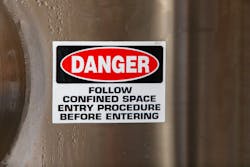You and Bob have a work order to change a light fixture inside an open vessel. Bob says he’ll go down and do the work. He tells you, “Stay topside in case something happens.” You decide to check text messages since you have nothing else to do while standing there. After a few minutes, you peer into the tank. To your horror, Bob is lying motionless on the bottom of the vessel.
Maybe he had a heart attack? Maybe he received a shock? Maybe there’s an accumulation of some gas in the vessel? Should you use your phone to call for help and then go down and get Bob? Can you hold your breath that long?
This is a high pressure situation, but under no circumstances should you enter that vessel. At a refinery in Louisiana, a worker called for help and then entered the vessel to rescue his coworker. When two operators arrived, they called in the situation and then amazingly they entered the vessel. All four people died. The next crew to arrive was equipped with rescue gear (including pullout straps), portable air supplies/masks, and a gas meter.
This situation was preventable. As with the real case, Bob died because of flagrant disregard for OSHA’s confined entry requirements. The real case was initially a tragedy of one death, but the response from three other people sealed their doom as well.
About the Author

Mark Lamendola
Mark is an expert in maintenance management, having racked up an impressive track record during his time working in the field. He also has extensive knowledge of, and practical expertise with, the National Electrical Code (NEC). Through his consulting business, he provides articles and training materials on electrical topics, specializing in making difficult subjects easy to understand and focusing on the practical aspects of electrical work.
Prior to starting his own business, Mark served as the Technical Editor on EC&M for six years, worked three years in nuclear maintenance, six years as a contract project engineer/project manager, three years as a systems engineer, and three years in plant maintenance management.
Mark earned an AAS degree from Rock Valley College, a BSEET from Columbia Pacific University, and an MBA from Lake Erie College. He’s also completed several related certifications over the years and even was formerly licensed as a Master Electrician. He is a Senior Member of the IEEE and past Chairman of the Kansas City Chapters of both the IEEE and the IEEE Computer Society. Mark also served as the program director for, a board member of, and webmaster of, the Midwest Chapter of the 7x24 Exchange. He has also held memberships with the following organizations: NETA, NFPA, International Association of Webmasters, and Institute of Certified Professional Managers.
